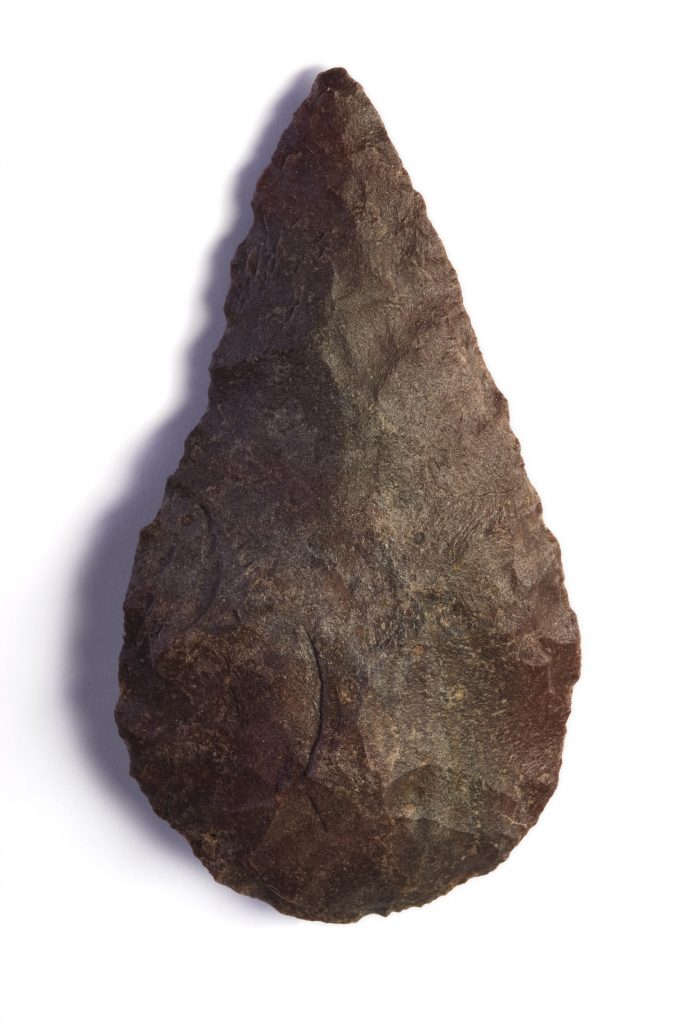The World’s Most Sustainable Technology
To my mind, a well-made Acheulean hand ax is one of the most beautiful and remarkable archaeological objects ever found anywhere on the planet. I love its clean, symmetrical lines. Its strength and heft impress me, and so does its persistence.
Acheulean hand ax is the term archaeologists now use to describe the distinctive stone-tool type first discovered by John Frere at Hoxne, in Suffolk, Great Britain, in the late 1700s. Jacques Boucher de Perthes, a celebrated archaeologist, found similar objects in France during excavations conducted in the 1830s and 1840s. The name Acheulean comes from the site of Saint-Acheul, near the town of Amiens in northern France, which de Perthes excavated in 1859.
The term hand ax is arguably a misnomer. While the stone tool could conceivably have been used to chop—as with a modern ax—there is little evidence the implement was attached to a handle. In the absence of a handle, the user would have seriously damaged his or her hands while holding onto the ax’s sharp edges and striking another hard substance. There is evidence, however—in the form of telltale microscopic damage to the hand-ax edges and surfaces—that these objects were used for slicing, scraping, and some woodworking activities. Hand axes also served as sources of raw material (in strict archaeological terms, they were cores) from which new, smaller cutting tools (flakes) were struck. So they likely served a range of purposes.
The vast majority of Acheulean hand axes were made by Homo erectus, an ancient human species that lived in Africa and was the first of our ancestors to move out of that continent. There are tantalizing hints that an earlier human ancestor found only in Africa, Homo habilis, may have made a crude form of hand ax, but never the beautifully symmetrical forms found later in time. Extinct human species found primarily in Western Europe, including the Neanderthals (who lived from about 400,000 to 40,000 years ago), also made hand axes. Members of our species, Homo sapiens, never made such tools. Acheulean hand axes have been found across Europe, Africa, and Asia, wherever suitably sized raw-material nodules may be found.
(In 1948, Harvard University’s Hallam Movius defined a theoretical line running from the middle of Great Britain east-southeast across northern Europe, skirting the northern reaches of the Black and Caspian Seas, across northern India, and all the way to Bangladesh in the southeast. Now known as the Movius Line, there are no hand axes found north and east of this boundary, probably due to lack of appropriate raw materials.)
Even more intriguing than their vast distribution across three continents is their time depth. Acheulean hand axes have been found at sites spanning 1.5 million years of human existence, dating from roughly 1.6 million years ago to about 100,000 years ago. That makes the Acheulean ax the most sustainable technology that members of our genus (Homo) ever developed. Consider, in contrast, the amount of technological change that has occurred in just the last 150 years (since the first telephone call), one ten-thousandth the amount of time the Acheulean hand ax was made and used. Or consider the amount of technological change in just the last 10 years (since the first iPhone was introduced), one one-hundred-fifty-thousandth the amount of time that Acheulean hand axes were made and used. In the memorable words of my former professor Arthur J. Jelinek, hand axes represent “mind-numbing technological stability.”
The hand ax thus represents a profoundly effective, highly sustainable technology used for 1.5 million years. Today we measure technological change in weeks and months, not just years. So what will today’s supposedly “sustainable” technologies look like in 10 years? 150 years? 1.5 million years? Next time you hear something about so-called sustainable technology, think about the Acheulean hand ax … and consider what the word sustainable really means.


























